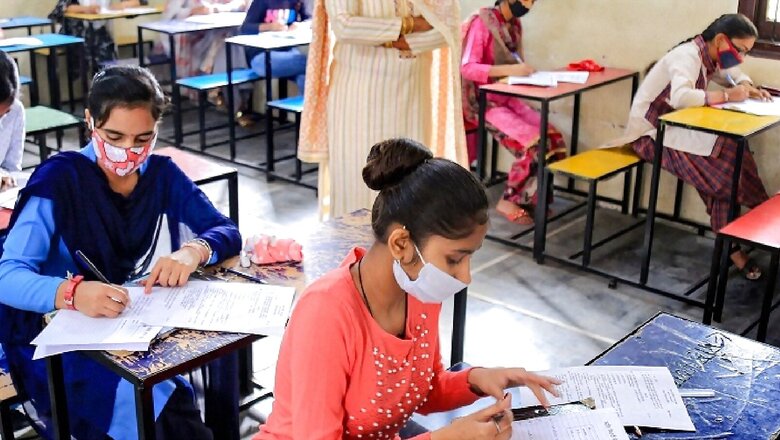
views
In July last year, India unveiled its first and most comprehensive education policy of the 21st century. As the first omnibus policy since 1986, the New Education Policy (NEP) 2020 has the onerous task of addressing multiple crises facing India’s education system. Addressing the completion of one year of the NEP, Prime Minister Narendra Modi remarked, “We are entering the 75th year of Independence. In a way, implementation of NEP has become a vital part of this occasion. This will play a key role in creating a new India and future-ready youth”. The Education Minister, Dharmendra Pradhan, called NEP 2020 a visionary education policy for the 21st century through which India is harnessing the capabilities of each student, universalising education, building capacities, and transforming the learning landscape in the country. He stressed that the NEP would make education holistic, affordable, accessible, and equitable. What has been the progress so far? Is the NEP roll-out on track? What are the major challenges facing this mega education policy in the coming decades?
Major Milestones
In the last 16 months since its eventful launch, the NEP has moved some ground in terms of meeting key milestones, notwithstanding the challenges from the global health pandemic. To begin with, the government has done well in terms of building awareness and interests amongst diverse stakeholders on the mission and vision of the NEP. This was marked in a 10-day long ‘Shikshak Parv’ that saw a series of national-level events featuring the Prime Minister and other key officials. Further, to make the intent more pronounced, the government has renamed the Ministry of Human Resources Development (MHRD) to the Ministry of Education. Significantly, this key ministry has been infused with doses of energy and dynamisms by bringing in Dharmendra Pradhan, the man who brought major transformations in the critical energy ministry. Mr Pradhan’s proven implementation ability and his diplomatic negotiating skills will come in handy in pushing the mega initiatives that would likely face opposition in Opposition-ruled states.
In terms of roll-out of key NEP activities, the school curriculum has been changed to include artificial intelligence (AI) and financial literary. Given that the mother tongue or regional language received primacy in the NEP, the same has been introduced in several states, albeit on a pilot basis. Further, the ministry has launched the much-talked-about Academic Bank of Credit—a programme that will provide multiple entry and exit options for students in higher education. These apart, a number of key initiatives, such as NIPUN Bharat Mission—improving children’s learning competencies in reading, writing, and numeracy by the end of Grade III; Vidya Pravesh—a three-month school preparation module for Grade I children; DIKSHA—a teaching-learning repository of e-content; and NISHTHA—teachers training programme for the secondary-level teachers. As far as roll-out amongst the states are concerned, only a handful of states, mainly under the ruling party have launched the programme. Karnataka became the first state to implement NEP on August 24.
Recently, Madhya Pradesh and Himachal Pradesh launched a series of NEP initiatives giving a much needed push to this mega policy. On the whole, NEP has started gathering pace.
Five Major Challenges
While the NEP has begun gathering a fair degree of momentum, the road to its realisation is filled with endless potholes. First, the sheer size and diversity of India’s education sector makes implementation an uphill task. For example, sample the size of the school education system alone. With more than 15 lakh schools, 25 crore students, and 89 lakh teachers, India remains the second largest education system in the world. The size of the higher education system is massive too. As per the AISHE 2019 report, India’s higher education sector consists of 3.74 crore students in nearly 1,000 universities, 39,931 colleges, and 10,725 stand-alone institutions. Thus, a countrywide implementation of this mega education policy is going to be a mammoth exercise involving multiple stakeholders at the state, district, sub-district, and block levels. Creating a shared responsibility and ownership amongst key stakeholders, including the private sector, at the state and district levels that have extraordinary diversity is going to be a major challenge for the education leadership.
Second, the NEP’s eventual realisation is critically linked to state capacity. As rightly pointed out by the NEP Drafting Committee led by K. Kasturirangan, India’s education system is underfunded, heavily bureaucratised, and lacks capacity for innovation and scale up. The internal capacities within the education ministries (centre and states) and other regulatory bodies are grossly inadequate to steer the magnitude of transformations envisaged in the NEP. For instance, moving away from a rigid content-driven rote learning system to experiential learning and critical thinking would require nothing short of a revolutionary change in the attitudes of the people running the education system, let alone the attitudinal changes amongst the teachers, students, and parents.
This means that thousands of schools and colleges would need capacity building and reorientation with regards to the operational aspects of implementing a mega programme with many experiential goals. In short, the existing organisational structure of the ministry and its ecosystems will have to undergo a massive overhaul. While it is heartening is that the NEP document has laid out a comprehensive roadmap for overhauling the existing regulatory system, and the education ministry is in the process of bringing out a legislation that would facilitate the setting up of a Higher Education Commission of India (in the place of existing regulatory bodies, mainly the UGC, AICTE, and National Council for Teachers Education), one has to wait for the new institutional architecture emerging out of legislative initiatives.
Third, the NEP would largely hinge on the extent of cooperation between the Centre and states. While the NEP has been drafted by the Union government (with inputs from multiple stakeholders including the state governments), its implementation largely depends on the active cooperation of the states. This is because most services-related education are performed by the state governments. In short, the Centre has to skillfully navigate the principles of cooperative federalism and decentralisation while rolling out key initiatives. And this is not an easy act to perform given the sharpening of political polarisation in the recent years and visible breakdown of trust between the Centre and states. A number of Opposition-ruled states have been raising strong objections to several key provisions of the NEP and the manner in which they are being rolled out. The more worrying development is that the Tamil Nadu government’s recent decision to not implement the NEP can encourage other Opposition-ruled states to follow a similar path. Thus, managing federal math is critical to the realisation of the NEP.
Fourth, the role of the private sector, particularly in dealing with the higher education system, is extremely critical for translating the inclusionary vision of the NEP. It may be noted that as much as 70% of higher education institutions (colleges and universities) are run by the private sector. Significantly, roughly 65-70% students are currently enrolled in private higher education institutions. This apart, the private sector brings much needed financial resources and innovation. Therefore, it is imperative for the government and regulatory bodies to create workable institutional mechanisms that would harness the contribution of the private sector and recognise them as equal partner in the NEP process.
Finally, the successful execution of key initiatives requires availability of adequate financial resources for decades. In this regard, the NEP has stated that to realise the goals of the new policy, the country has to raise public spending on education to 6% of GDP. This is a daunting task if one considers the past promises and their actual realisation. For instance, the 1968 National Education policy had recommended 6% of GDP be allocated towards education. However, in all these decades, the public spending on education has not gone beyond 3%. Ironically, the union budget allocation for education in the NEP launching year has taken a dip. The education budget was reduced by 6% from INR 99,311 crore in 2020-21 to INR 93,224 crore in 2021-22. While this is understandable given the government’s priorities are divided in the face of the COVID-19 pandemic and economic distress that large sections of populations are facing, there is no clear roadmap yet how such enormous sums of financial resources can be augmented.
To sum up, the NEP 2020 is truly a path-breaking document in every sense. The policy, amongst others, aims to address pedagogical issues, structural inequities, broadening of access apart from making the learners future ready while meeting the demands of a 21st century India. Simultaneously, the NEP has the most challenging task of addressing multiple crises in the education system. Its effective implementation is critical if India wants to reap the demographic dividends and capitalise the opportunities from a rapidly growing knowledge economy. Given its transformative potentials, the Centre has shown urgency and a sense of purpose by launching a series of initiatives in the recent months notwithstanding the challenges of the pandemic. A number of states have officially launched the policy and many others are in the process to do the same. Yet, there is a long road ahead of the NEP. Given its scale and the kind of complexity involved in its execution, particularly securing coordination and cooperation amongst diverse stakeholders at state, district, private sector amongst others, makes it a daunting exercise.
Apart from this, one has to deal with weak state capacity, availability of financial resources and, most importantly, the education ecosystem that acts as a drag on new ideas and innovation. Yet, the most critical challenge before NEP is building consensus and getting states to own the first omnibus programme after 1986. In short, the success of the NEP largely hinges on cooperative federalism and states taking ownership of the reforms.
The article was first published in ORF
Niranjan Sahoo, PhD, is a Senior Fellow with ORF’s Governance and Politics Initiative. The views expressed in this article are those of the author and do not represent the stand of this publication.
Read all the Latest Opinions here

















Comments
0 comment